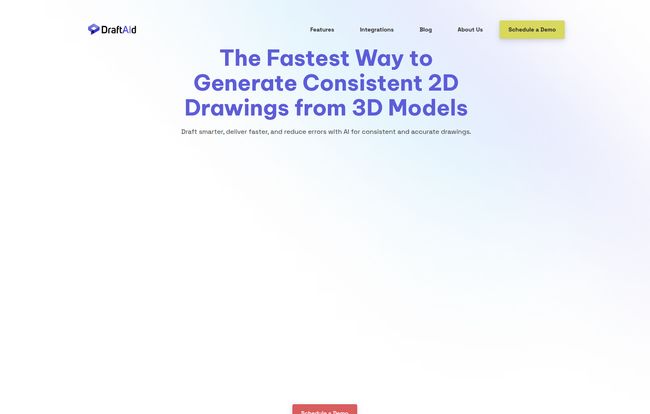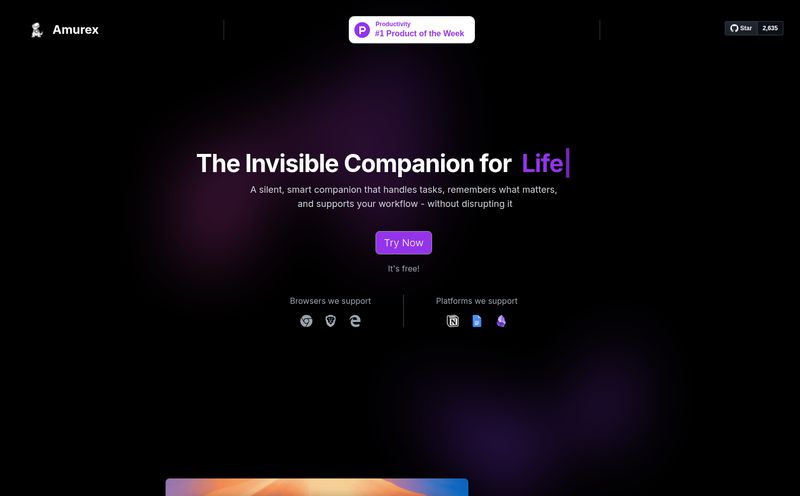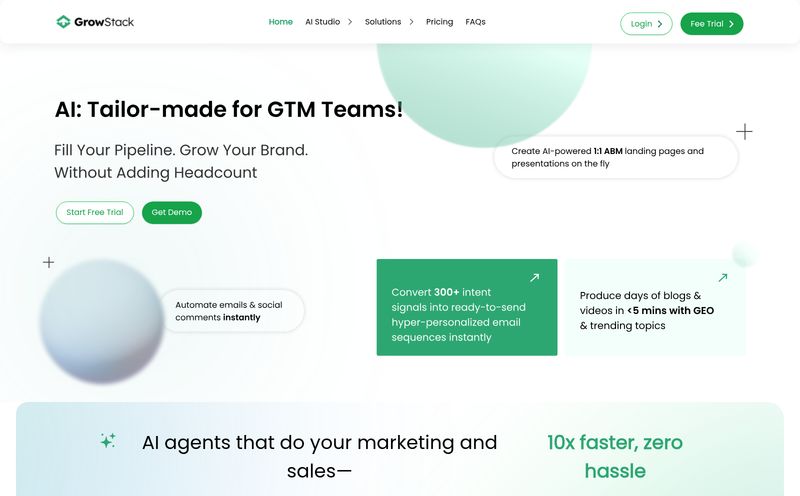The Bottleneck No One Talks About
We love talking about the sexy parts of engineering and design. The brainstorming, the 3D modeling, the satisfying click when a complex assembly finally fits together in SolidWorks. But there's a dark, soul-sucking secret we all share: creating the 2D manufacturing drawings.
I've been there. It's 10 PM, the coffee is cold, and you're staring at a screen, manually placing dimensions on a drawing that has fifty components. You move one thing, and a cascade of annotations needs to be fixed. It’s tedious. It's repetitive. And honestly, it's a colossal waste of a skilled engineer's time. For years, I’ve thought, "There has got to be a better way."
Well, it looks like that "better way" might have finally arrived. It’s called DraftAid, and it's one of those AI tools that doesn't feel like a gimmick. It feels like a solution to a problem I’ve had for a decade.
So What Exactly is This DraftAid Thing?
Put simply, DraftAid is an AI-powered tool that automates the generation of those detailed 2D engineering drawings directly from your 3D models. You feed it a 3D part or assembly file, and with a click, it spits out a production-ready 2D drawing.
Think about that. It’s not just creating the basic front, top, and side views. It’s intelligently placing dimensions, adding annotations, creating section views, and formatting it all based on predefined standards. It’s like having a super-fast, hyper-accurate junior drafter who never needs a coffee break.

Visit DraftAid
This isn't about replacing your primary CAD software like Inventor or SolidWorks. It's a powerful sidekick, a plugin that integrates with the tools you already use to obliterate the most boring part of your job.
The Features That Genuinely Make a Difference
I've seen a lot of tools promise the world, but the feature set here seems grounded in solving real-world headaches.
The Magic of AI-Powered Drawing Generation
This is the core of it all. The AI isn't just taking a screenshot of your model. It understands the geometry. It knows what a critical feature is and how to represent it clearly on a 2D plane. It automates the creation of orthographic, isometric, and detailed views, which is the foundation of any good drawing package. This alone is a huge time-saver.
Automated Dimensioning and Annotations
Okay, this is where my jaw dropped a little. The sheer amount of time I've spent meticulously placing dimensions and callouts... it's probably weeks of my life. DraftAid’s ability to automatically apply dimensions and annotations is a game-changer. It analyzes the model and places dimensions logically to fully define the part. Sure, you might need to tweak a few things for clarity, but it gets you 90% of the way there in seconds. Seconds!
Customization Is King
No two companies are the same, and neither are their drawing standards. A tool that forces you into a rigid template is a non-starter. DraftAid gets this. You can customize templates, title blocks, dimensioning styles, and layering systems to match your company's specific requirements. This means the output is consistent and immediately usable, without needing a complete overhaul to meet internal standards. This is a big deal for maintaining quality control.
Plays Nice with Your Existing Tools
The biggest barrier to adopting new software is always the workflow disruption. The team behind DraftAid seems to be keenly aware of this. It's built to integrate directly with major CAD platforms. The website mentions seamless integration, which means you’re not exporting and importing files all day, a process that is ripe for errors. It just slots into your current process, which makes adoption so much easier.
My Honest Take: The Good and The... Minor Hurdles
No tool is perfect, right? But from what I've seen, the pros here heavily outweigh the cons.
What I Love About DraftAid
The time savings are obvious. They claim it significantly reduces drafting time, and I believe it. Cutting hours of manual work down to minutes is an incredible value proposition. This frees up engineers to do what they're actually paid to do: innovate, solve problems, and design better products, not just document them.
But it’s more than just speed. It's about accuracy and consistency. When a human is placing hundreds of dimensions, mistakes will happen. A typo in a dimension can lead to thousands of dollars in scrap parts or rework. By automating this, DraftAid introduces a level of consistency that’s difficult for a team of humans to match, especially under pressure. Every drawing follows the same rules, every time. That’s huge.
A Couple of Caveats to Consider
Okay, so what's the catch? The official "cons" list a couple of things. First, an "initial learning phase." I mean, of course. Any powerful new tool requires a bit of setup and learning to get the output just right. You’ll have to configure your templates and standards. But let's be realistic, spending a few hours upfront to save hundreds of hours down the line is a trade I'll make any day of the week.
The second point is that it "requires 3D models as input." To be blunt, this is barely a con in 2024. If your engineering workflow doesn't start with a 3D model, you're already behind the curve. Modern design and manufacturing are model-based. So, this is less of a limitation and more of a prerequisite for any modern engineering team.
The Big Question: What's the Price Tag?
Alright, the part everyone wants to know. What does DraftAid cost? I went looking for a pricing page... and found a "No such page" error. This is pretty common in the B2B software world. Instead of a tiered pricing list, you'll find a "Schedule a Demo" button.
Don't let this scare you. This usually means the pricing is customized based on the size of your team, your specific needs, and the level of integration required. It’s an enterprise sales model. It allows them to talk to you, understand your pain points, and quote a solution that fits, rather than selling a one-size-fits-all package. My advice? If you're feeling the pain of manual drafting, scheduling that demo is probably worth your time.
Who Should Be Scheduling That Demo, Anyway?
Is DraftAid for everyone? Probably not. If you're a hobbyist or a one-person shop doing very simple parts, the cost might not make sense.
But if you are one of the following, you should be paying attention:
- Mechanical Engineers & Design Teams: This is the bullseye. If your team spends more than a couple hours a week creating 2D drawings from your 3D CAD, this tool is built for you.
- Manufacturing Companies: Any company that relies on detailed shop drawings to produce parts can benefit from the speed and consistency. Fewer drawing errors means less scrap and higher quality.
- Engineering Managers: You're not just saving time; you're increasing your team's throughput and allowing them to focus on higher-value tasks. It's a force multiplier.
Essentially, if the phrase "production-ready drawing package" is part of your daily vocabulary, DraftAid is speaking your language.
Frequently Asked Questions About DraftAid
Does DraftAid completely replace my CAD software like SolidWorks?
Absolutely not. It's designed to be an add-on or integration, not a replacement. You'll still do all your 3D modeling and design work in your primary CAD program. DraftAid just takes over the tedious 2D documentation part of the process.
Is it actually hard to learn?
Based on the premise, the day-to-day use should be incredibly simple (it's pitched as a one-click solution). The "learning" part is likely in the initial setup—configuring your company's unique drawing standards, title blocks, and dimensioning preferences to ensure the AI's output is exactly what you need.
Can I really customize the drawings to my company's strict standards?
Yes, this seems to be one of its core strengths. They emphasize customizable templates and standards, which is critical for professional use. You wouldn't want drawings that look completely different from the rest of your documentation.
What specific CAD programs does DraftAid work with?
The website specifically mentions integration with popular tools like SolidWorks and Inventor. For other platforms, you'd likely need to ask during a demo. They are likely expanding their integrations over time.
How does it handle really complex assemblies?
This is a great question and probably a key topic for a demo. A good automation tool should be able to create assembly drawings with exploded views, bills of materials (BOMs), and balloon callouts. Given its target audience, it's highly likely DraftAid has robust features for handling assemblies, not just simple parts.
Is there a free trial?
Since there's no public pricing, there's likely no public "free trial" button. However, the "Schedule a Demo" model often includes a guided proof-of-concept or a limited trial period after you've spoken with their team to ensure it's a good fit.
The Final Draft
Look, the world of engineering is finally getting the smart AI tools that other industries have had for a few years. For too long, we've been stuck with powerful but manually intensive software.
DraftAid appears to be a genuinely useful application of AI, aimed squarely at one of the most inefficient and frustrating parts of the design-to-manufacturing process. It’s not about taking jobs; it's about augmenting skilled professionals and freeing them from drudgery. It lets engineers be engineers.
If you're tired of the late nights, the endless revisions, and the mind-numbing task of creating 2D drawings, then you owe it to yourself to see what tools like DraftAid can do. This feels less like a minor upgrade and more like a fundamental shift in how we work. And I, for one, am here for it.
References and Sources
For more information or to see the tool in action, you can visit the official website:
- DraftAid Official Website: https://www.draftaid.com/



